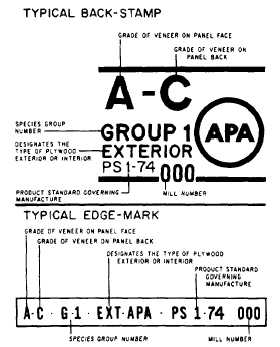Plywood can be worked quickly and easily with common carpentry tools. It holds nails well and normally does not split when nails are driven close to the edges. Finishing plywood presents no unusual problems; it can be sanded or texture coated with a permanent finish or left to weather naturally.
There is probably no other building material as versatile as plywood. It is used for concrete forms, wall and roof sheathing, flooring, box beams, soffits, stressed-skin panels, paneling, shelving, doors, furniture, cabinets, crates, signs, and many other items.
Softwood Plywood Grades
All plywood panels are quality graded based on products standards (currently PS 1/74). The grade of each type of plywood is determined by the kind of veneer (N, A, B, C, or D) used for the face and back of the panel and by the type of glue used in construction. The plywood veneer grades are shown in table 3-7.
Many species of softwood are used in making plywood. There are five separate plywood groups based on stiffness and strength. Group 1 includes the stiffest and strongest; group 5 includes the weakest woods. A listing of groupings and associated woods is shown in table 3-8.

Figure 3-37.-Standard plywood identification symbols.
GRADE/TRADEMARK STAMP. - Construction and industrial plywood panels are marked with different stamps.
Construction Panels. - Grading identification stamps (such as those shown in figure 3-37) indicate the kind and type of plywood. The stamps are placed on the back and sometimes on the edges of each sheet of plywood.
For example, a sheet of plywood having the designation "A-C" would have A-grade veneer on the face and C-grade veneer on the back. Grading is also based on the number of defects, such as knotholes, pitch pockets, splits, discolorations, and patches in the face of each panel. Each panel or sheet of plywood has a stamp on the back that gives all the information you need. Table 3-9 lists some uses for construction- grade plywood.
Industrial Panels. - Structural and sheeting panels have a stamp found on the back. A typical example for an industrial panel grade of plywood is shown in figure 3-38.
The span rating shows a pair of numbers separated by a slash mark (/). The number on the left indicates the maximum recommended span in inches when the plywood is used as roof decking (sheeting). The right-hand number applies to span when the plywood is used as subflooring. The rating applies only when the sheet is placed the long dimension across three or more supports. Generally, the larger the span rating, the greater the stiffness of the panel.
Figure 3-39 lists some typical engineered grades of plywood. Included are descriptions and most common uses.

Figure 3-38.-Structural stamp.
Continue Reading